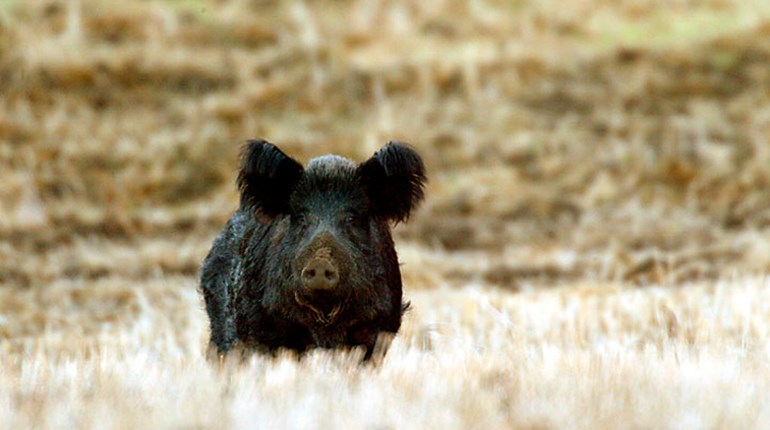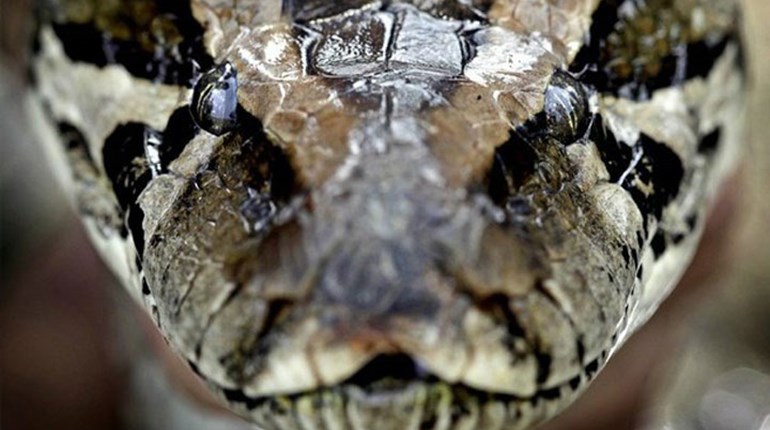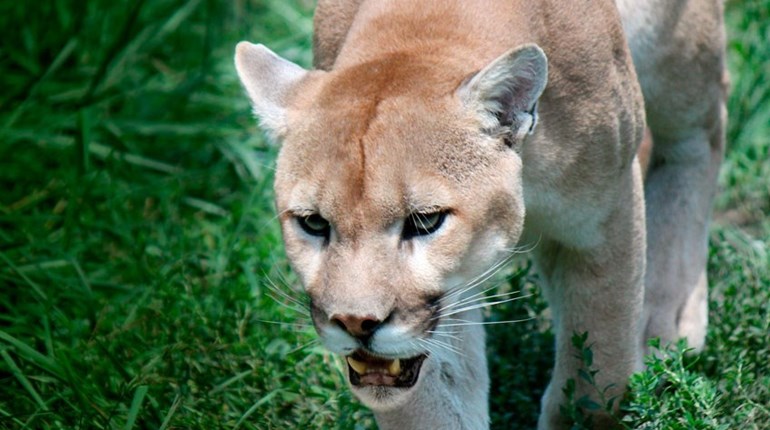This close to the Baltic Sea the air was as damp as it was cold. Ice crystals hung suspended, forming a coarse, granular sort of fog. It was as if a fine, misting snow had frozen in place, hanging in the thick, cold air and defying gravity. Large, thick patches of it filled the open areas while in the shelter of the woods the air was clear, as if the trees had won a great battle to be fog-free while the fields remained under siege.
I had approached my stand by crossing an icy, water-filled ditch while balancing on a couple of small logs placed side by side. This foolish little bridge was covered with ice and snow and while the drop was not far, the landing would no doubt be cold and wet, so I executed my navigation with great care.
The stand was a small, wooden box on legs perched about 3 feet above the ground. With all my heavy clothing, it was barely large enough for me to back into. There was a thin, snow-covered board for a seat, and I brushed off the top layer to find an inch of crystalized ice bonded to the wood. When I sat, the board bent and bowed until I decided the prudent, and warmer, approach would be to stand. An hour later, my feet and my knees were protesting that decision with great enthusiasm.
The worst part of any driven hunt is hearing the shooting going on all over the known world, with the exception of your stand. Clearly, everybody else on the hunt has drawn a better stand. There are guns going off all over Lithuania, except in a large radius with your position in the center. In that circle it is dead-still, nothing is moving—no game and no bullets.
You feel like the only kid in class who didn’t get an invitation to the party. It’s like being the last one picked for the baseball team, or standing against the wall all alone at the junior-high dance. Even decades later, all those memories of being left out, picked last and shunned by those getting the action will resurface as you listen and pretend you don’t care.When the beaters approach you can hear their sing-song yelps and yells, with a cadence that is almost a musical beat. Later you will learn to recognize each of them by their trademark voice patterns, but on this first drive of the hunt it’s all new and very exotic.The dogs appear first, running past your stand, and then reversing to stop in front and look briefly at you with just a little bit of disdain. The men follow next, some dressed in great, long, ankle-length raincoats and high rubber boots, and all sporting bright orange vests. The older men pass by without a glance while the younger ones offer a small head bump of recognition. Perhaps they see you as a brother in arms, a fellow outcast who has not yet earned a place in the pecking order.
They regroup along the power line opening in front of my stand, with much hand waving and shouting in their unique Lithuanian Baltic language. There seems to be a power struggle going on about which one is in charge and for a while the term “herding cats” comes to mind. Then a tall, gray-haired man bellows for the first time and it all calms down and reforms with military precision. Once each driver is back in position they began again, moving away from my stand, singing their primitive songs and pushing the game farther away. The drive is only half-finished but, for me, I know it’s over. My heart sinks, knowing the next chance is hours away—that I will stand here, pouting in the snow, alone, ignored and feeling very sorry for myself, waiting until the afternoon drive starts hours later. No doubt I’ll again have the worst stand possible when it does.
Then a shot rings out to my left, so close it startles me and adrenaline slashes through my stomach and chest. I had no idea there were other hunters so near and I realize that more than just myself have been left out of this event. Another shot, this one even closer, dials my focus down even more. I have my gun up and ready as I watch to my left in the direction of the shots, quivering like a pointer on a bird; ready, focused, taut with anticipation.
It’s the best feeling in the world.
Even after several boar hunts, I am still caught off guard. When they first appear, dark against the white snow, wild, primitive and oh so exotic, I am stunned into inaction.
It’s true! Wild boar are lurking about these woods. Until now it was just a concept. My hesitation seems long, but it’s just a small fraction of a short second. There were multiple boar running through a small opening in the high grass and deep snow. The red dot of my sight hits the leading edge of the opening just as the biggest one’s nose enters. I find the lead, keep the gun moving and break a shot. The boar staggers as I hear the bullet impact, but it recovers and runs into the woods. Later I would find the 400-pound brute dead 10 yards into the brush, a hole ripped through its heart, but for now, I feel like one of the cool kids.
Two days earlier, we had arrived in Vilnius, the capital of Lithuania, early enough to allow several hours of exploring this historic city. I am often shocked at companions who are right there, with the time on their hands and have no interest in exploring this big wonderful world. Me? I want to see it all. We were in a city with a long and interesting history dating back at least to 1323 when the first known writings about it appeared. With the possibilities that promised, spending the afternoon in my room with a television would be impossible.
One of the best parts of traveling to hunt is the fringe benefits. Without hunting trips I would never have watched them dance the tango in Buenos Aires, or bartered with a beautiful Masai girl at a mahogany market in Dar es Salaam. I would not have seen the Hunter’s Museum in Munich or lost Mayan ruins in the Yucatan. I would never have explored a jaguar cave or watched 7 million bats exit a sinkhole at dusk. I wouldn’t have seen the wild interior of Russia or explored Pretoria. I might have missed out on Little Big Horn and the hot springs of Yellowstone. Without hunting trips I would never have sipped tequila in a forgotten Mexican bar while listening to a one-man mariachi band or visited the grave site of Eva Peron. I would have missed out on singing American rock-and-roll with the Russian mafia at a karaoke bar in Izhevsk and would never have experienced swimming in the Zambezi River. I would not have been in a small tent, stranded by a whiteout, far above the Arctic Circle with an Eskimo man who turned out to be one of the most interesting people I have ever met. I would not have been inside Tchaikovsky’s home or visited Red Square. Without hunting trips I would not have been to Hitler’s viewing stand in Nuremberg or met the Zulus of Natal. Without hunting and without the thirst to explore beyond the hunt, life would not have been so interesting. Hunting is so much more than just “killing stuff.” It’s a gateway that opens doors to adventure.
I left the hotel with my new friend, Burkhard Bonarius, the PR director for J.P. Sauer Rifles. We walked for miles, exploring the city. The architecture was incredible. We walked randomly, letting whimsy surprise us with each new corner. This was a country of contrasts, one that endured occupation and emerged to become one of the strongest economies in Europe, only to again fall siege to the economic crisis. It was all there, written in the buildings and on the faces of the people if you knew how to read the language.
The Soviet influence is still strong, evidenced by the huge bronze statues guarding the Green Bridge across the Neris River that splits the city. This historic bridge dates back to 1536 and has a checkered history. It has been burned no less than three times and blown up at least once. The current bridge is guarded by four sets of sculptures, one on each corner. They are indicative of the Soviet myth. They each feature two people, representing social classes idealized by the Soviet lies: soldiers, workers, farmers, students.
On March 11, 1990, Lithuania became the first Soviet republic to declare independence from the Soviet Union. That ended a brutal occupation dating back to 1940 and it puzzles me why the statues are allowed to remain.
While exploring the city, we happened on the Museum of Genocide Victims, which is dedicated to collecting and exhibiting documents relating to the 50-year occupation of Lithuania by the Soviet Union. Late on a Sunday night, the museum was closed, but it was sobering to see the outside walls, each building block an engraved tombstone for someone killed by Stalin; their deaths all occurred in a relatively short time span. One man had fundamentally changed this place at the barrel of a gun, because only he had the guns. I walked away knowing I had changed and wondering how I would fare under such oppression. Not well, I am sure. Had I been born in another time and place my name could well be on one of those stones. It made me appreciate the freedoms that we have as Americans, and it was a brutal reminder of just how quickly we could lose it all.
It was a long bus ride to where we would hunt, near the town of Palanga, on the Baltic Sea. While the hunt was primarily for wild boar, we could also shoot female roe deer and female red deer. The problem was that the males had shed their antlers and a mistake would be costly. I saw several roe deer, but never was sure enough about what I was looking at to pull the trigger. Twice they moved past my stand and were shot by other hunters. Also on the “shoot them” list were red fox and raccoon dogs. The raccoon dog is a tree-climbing canine that is native to East Asia and is considered an invasive species here.
While not related, they look remarkably like a raccoon, hence the name.
For the uninitiated, a driven boar hunt is something that will give the average American hunter-safety instructor cold sweats at night. The game is chased to waiting shooters and, almost without exception, it is shot while running.
Despite the disorganization I witnessed that first morning, which proved to be a one-time thing, these drives are conducted with military precision. Each person knows his job. The hunters are carefully placed so that the shots are directed down into the ground. The drivers make enough noise that the hunters know their locations at all times. It’s far less dangerous than it sounds. This is the primary way that boar and many other animals are hunted throughout most of Europe. The safety record is excellent.
I am not sure exactly when it happened, but the American culture has decided that shots at running game are unethical. There was a time, before America became feminized and stifled, when shooting at running game was the norm. Writers such as Townsend Whelen and Jack O’Connor wrote instructional articles on how to hit running game and magazines published them quite regularly. There were running-deer competitions at most shooting ranges; hitting running game with a rifle was a skill that hunters were expected to learn. I grew up in a camp full of trackers and still-hunters and was well into my 20s before I realized you could shoot a deer that’s not running. I am not exactly sure how all of that changed, but when I write about shooting at running game today, I get a lot of hate-filled letters, most calling me names and questioning my credentials as a hunter.
In Europe shooting running game is a tradition and, just as with American hunters of the past, you are expected to acquire the skill. The traditional way to learn is on a running-boar target, which can be found on any shooting range. In today’s high-tech world there are also shooting theaters, like the one I shot in at the Blaser factory in Germany before this hunt. With these popular shooting theaters you can hone your skills shooting live ammo at a movie screen with running boar or other game playing out like a movie. A computer records your hits or misses so you can review your performance after the shot.
They are a great training aid and are becoming very popular throughout Europe.Before a boar hunt just about anywhere in Europe, the hunters must prove their abilities on a running-boar target before they are allowed to hunt. (In Sweden a few years prior, for example, we used a running-moose target, which is much easier to hit!)
Even if you make a poor shot on the boar, which can happen with standing game as well as running game, they have tracking dogs that are trained to find the wounded game. As far as I know, we didn’t lose any wounded animals during the entire hunt.
A European driven hunt is a fast-moving, exciting way to hunt wild boar. You never know what to expect. It might be one boar or a dozen that shows up at your stand. There are no bag limits so you can shoot as many as you want.
One afternoon I was up the road from Aimpoint’s Sabine Eriksson when I heard her start shooting. From my perspective, it looked like she was in a castle battlement and under siege by wild boar. It appeared like a dozen or more were attempting to overrun her position while she was shooting in self-defense. I expected to see her pouring boiling oil on them any second.
My luck improved and I saw game from every stand but one during the three-day hunt. I had opportunities to shoot on about half the drives, which is a good balance. In one instance, those years of 3-gun competition paid off as five boars crossed the small opening I was watching. I started with the lead boar and, moving back like running a plate rack, I fired three shots and got three wild boars in about two seconds.
The meat is sold to restaurants so that the public can enjoy one of the better game meats, but the excitement, memories and freedoms of such a day remain mine forever.





































